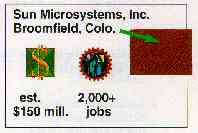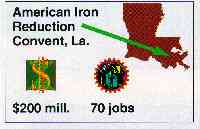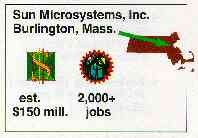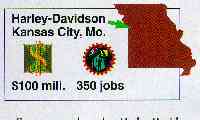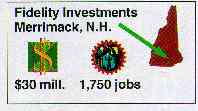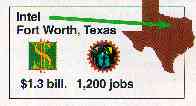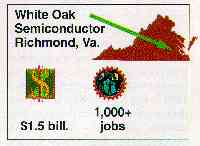 The deal. For expansion-minded firms, it?s the alpha and omega of economic enterprise, the rocket fuel of business growth. Good deals deliver: capacity, jobs, profits and prosperity. Every day, development projects evolve into good deals for both the company and the community, and thousands are sealed every year. Some of the best, though, are object lessons in patience and professionalism for economic developers. For expanding firms, some development projects drive traditional growth in capacity or efficiencies; others fuel strategic initiatives to derive new competitive advantages, with infinite possible combinations of expansion modes. The top deals among hundreds of development projects announced in 1996 — as judged by the editors of Site Selection — offer insights into cutting-edge strategic management practices. |
AK Steel Rockport, Ind.; $1.1 bill.; 410 jobs Industry analysts say AK Steel?s Rockport, Ind., complex represents a strategic departure for the integrated steel maker: The Rockport Works will not create additional raw steel capacity (the project lacks steel melting and refining facilities). Instead, it will create additional finishing capacity and produce the widest rolls of steel in the world, enhancing mill productivity. With up to $72 million in combined state and local incentives, the plant?s per-job cost could reach $175,000, making the project the most expensive economic development effort in Indiana history, observers say. American Iron Reduction; Convent, La.; $200 mill.; 70 jobs When the process technology for the joint venture between Birmingham Steel and GS Industries was decided, it didn?t take a lot of hard thinking to turn away from Venezuela and toward the U.S. Gulf Coast. Fidelity Investments; Merrimack, N.H.; $50 mill.; 1,750 jobs Price, performance and location were the key criteria for Fidelity?s decision to locate in Merrimack, with a planned work force of 1,750 by the end of 1997, explains Ronald C. Duff, president of Fidelity Corporate Real Estate. Harley-Davidson; Kansas City, Mo.; $100 mill.; 350 jobs ?This facility is a once-in-a-century catch for Kansas City,? Mayor Emanuel Cleaver bragged to reporters. The plant also is expected to bring 20 new suppliers to town once Harley begins making Sportster bikes. Intel; Fort Worth, Texas; $1.3 bill.; 1,200 jobs Latest to bubble to the top of the short list is Fort Worth. ?We?d been considering Texas for many years,? says Pawlak. MSNBC, Secaucus, N.J.; $550 mill.; 490 jobs To 24-hour cable news channel MSNBC, New Jersey?s generous economic incentive plan ?made it easy for us to make a final decision,? network President Robert Wright announced. In the end, the deal was structured to allow NBC parent GE Capital to purchase $150 million in state-issued, low-interest bonds to finance new equipment and other expenses. Sun Microsystems, Inc. The expansion triple play meets many needs: access to essential brainpower and harmony of internal infrastructure, including workplace design.
Toyota, Buffalo, W. Va.; $400 mill.; 300 jobs WaferTech, Camas, Wash.; $1.2 bill.; 800 jobs The location decision was driven as much by strategy as by the location of the partners, Norris explains. ?Half our customer base is in the United States. This is the source of the technology evolution.? says. White Oak, Richmond, Va.; $1.5 bill.; 1,000+ jobs The chips will primarily be used for personal computers, and is Siemens? first major semiconductor facility in the United States. The joint venture is Motorola?s second planned facility in Richmond. The first plant is expected to produce PowerPC chips by 1999. |
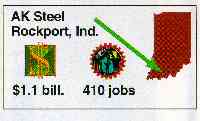
|

 Subscribe to Site Selection Magazine
Subscribe to Site Selection Magazine
Feedback]|[
Search for
any topic]
Copyright 1997 Conway Data, Inc. All rights reserved
Legal Notice: Because data comes from many sources, Conway Data
can assume no responsibility for accuracy or currency.


